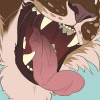
As mentioned in the other parts of this series, this Paw Study is part of the Balaa’s “Artist Conspiracy” series, who’s whole purpose is to provide both good reference pictures for artists as well as inspiration to try them out in new artwork! There are nine pictures in this series, with the “number zero” having been posted a long, long time ago now: http://www.furaffinity.net/view/432365/
As this /is/ a Paw Study, I thought the very best candidate for modeling would best be a kitty with very large and imposing paws, who doesn’t mind showing them off. So, logically, that led me to The DrifterMan, who was more than happy to volunteer.
Once again, I put up for display a less than ideal photograph. Yet, in the context of a Paw Study, this photograph does have merit, even though it’s more blurry than I like to display.
Some Feline Trivia items of note are similar to the ones mentioned previously. Once again it can be clearly seen that it would appear the lines do indeed have individual control over their claws, in contrast to the general thought that all claws must extend or retract together. Likewise, it is commonly thought that the out-stretching of the forepaws and forelegs will automatically result in the extension of the claws. I believe this picture can easily disprove both those popular theories.
The basic situation in this picture is that Drifter has just stood up from perhaps a lengthy nap and needs to do the typical just-standing-up stretch. This photo was snapped just after the shoulders have dipped, and the body swings back, for that wonderfully invigorating back flex. While Drifter is clearly flexing his forepaws, it can also be seen that while several claws are almost fully extended, several others are not extended at all. It can also be seen that Drifter’s forelegs are generously extended forward, and yet the vast majority of the claws are not extended. So, in this case, this photograph is a clear display which dispels both of the popular claw-extension theories.
The other reason I chose this particular photograph was once again for the display of the general and basic structural design of the feline paw. As is visible on Drifter’s left forepaw it would appear as though he has complete control over each individual digit. For example, the equivalent of the “index finger” as the claw approximately half-extended, and lost the digit laying much flatter than the digits to either side, whose knuckles can be clearly seen over that of the digit with the extended claw.
Another note worthy of mention partially displayed by this picture, is the musculature of the foreleg. In this photo, Drifter’s right foreleg is quite visible, including the rather impressive set of muscles, which just like in the human forearm, control much of the movement of the digits and subsequently claws. The bone structure from elbow to wrist is also very similar, including the equivalent bones of the ulna and radius, which like in the human forearm, allow drifter to twist his paw almost 180-degrees.
So this photo, which is the ninth and last image (at least for now), concludes the series of the “Drifter Paw Study”. I truly hope that it proved to be both informative, as well as a help to those of artistic ability, in providing some good reference material for your continued endeavors at feline related artworks!
This picture was taken 10-Jun-05. The image was taken with a Canon EOS 10D and the EF 28-200mm f/3.5-5.6 USM lens. The original was taken at full frame of 3072x2048x24b, ISO eqv 400, 1/180 shutter, f/6.7. This image was shrunken down for space conservation.
As this /is/ a Paw Study, I thought the very best candidate for modeling would best be a kitty with very large and imposing paws, who doesn’t mind showing them off. So, logically, that led me to The DrifterMan, who was more than happy to volunteer.
Once again, I put up for display a less than ideal photograph. Yet, in the context of a Paw Study, this photograph does have merit, even though it’s more blurry than I like to display.
Some Feline Trivia items of note are similar to the ones mentioned previously. Once again it can be clearly seen that it would appear the lines do indeed have individual control over their claws, in contrast to the general thought that all claws must extend or retract together. Likewise, it is commonly thought that the out-stretching of the forepaws and forelegs will automatically result in the extension of the claws. I believe this picture can easily disprove both those popular theories.
The basic situation in this picture is that Drifter has just stood up from perhaps a lengthy nap and needs to do the typical just-standing-up stretch. This photo was snapped just after the shoulders have dipped, and the body swings back, for that wonderfully invigorating back flex. While Drifter is clearly flexing his forepaws, it can also be seen that while several claws are almost fully extended, several others are not extended at all. It can also be seen that Drifter’s forelegs are generously extended forward, and yet the vast majority of the claws are not extended. So, in this case, this photograph is a clear display which dispels both of the popular claw-extension theories.
The other reason I chose this particular photograph was once again for the display of the general and basic structural design of the feline paw. As is visible on Drifter’s left forepaw it would appear as though he has complete control over each individual digit. For example, the equivalent of the “index finger” as the claw approximately half-extended, and lost the digit laying much flatter than the digits to either side, whose knuckles can be clearly seen over that of the digit with the extended claw.
Another note worthy of mention partially displayed by this picture, is the musculature of the foreleg. In this photo, Drifter’s right foreleg is quite visible, including the rather impressive set of muscles, which just like in the human forearm, control much of the movement of the digits and subsequently claws. The bone structure from elbow to wrist is also very similar, including the equivalent bones of the ulna and radius, which like in the human forearm, allow drifter to twist his paw almost 180-degrees.
So this photo, which is the ninth and last image (at least for now), concludes the series of the “Drifter Paw Study”. I truly hope that it proved to be both informative, as well as a help to those of artistic ability, in providing some good reference material for your continued endeavors at feline related artworks!
This picture was taken 10-Jun-05. The image was taken with a Canon EOS 10D and the EF 28-200mm f/3.5-5.6 USM lens. The original was taken at full frame of 3072x2048x24b, ISO eqv 400, 1/180 shutter, f/6.7. This image was shrunken down for space conservation.
Category Photography / Animal related (non-anthro)
Species Housecat
Size 1280 x 854px
File Size 129.4 kB
(belatedly) I have found over the years that most big cats, if they will tolerate us touching their paws, will all respond similarly to having a finger rubbed inbetween the paw-pads, namely, between the big and small pads. You can actually feel all the various bones of the digits quite well, and usually, they will respond by curling their paws just slightly, which usually has the asses reaction of flexing the claws out. Drifter does this 50/50, as sometimes, he doesn't like his paws touched at all, and other times, he'll almost roll his forepaws into a fist with his claws all the way out, which is always fun, as then I get and up-close-and-personal view of his claws, with the added bonus of making sure they're all fit and healthy. :)
(Shasta grins belatedly) I like this one, as no only does it show the paws quite well, but just because of the angles, there's a lot of the "mechanical structure" of the paws that becomes visible when the claws are flexed, and this photo does reasonably well at capturing a bit of that. :) So, I'm glad you liked it, and I hope it's useful.

 FA+
FA+










Comments